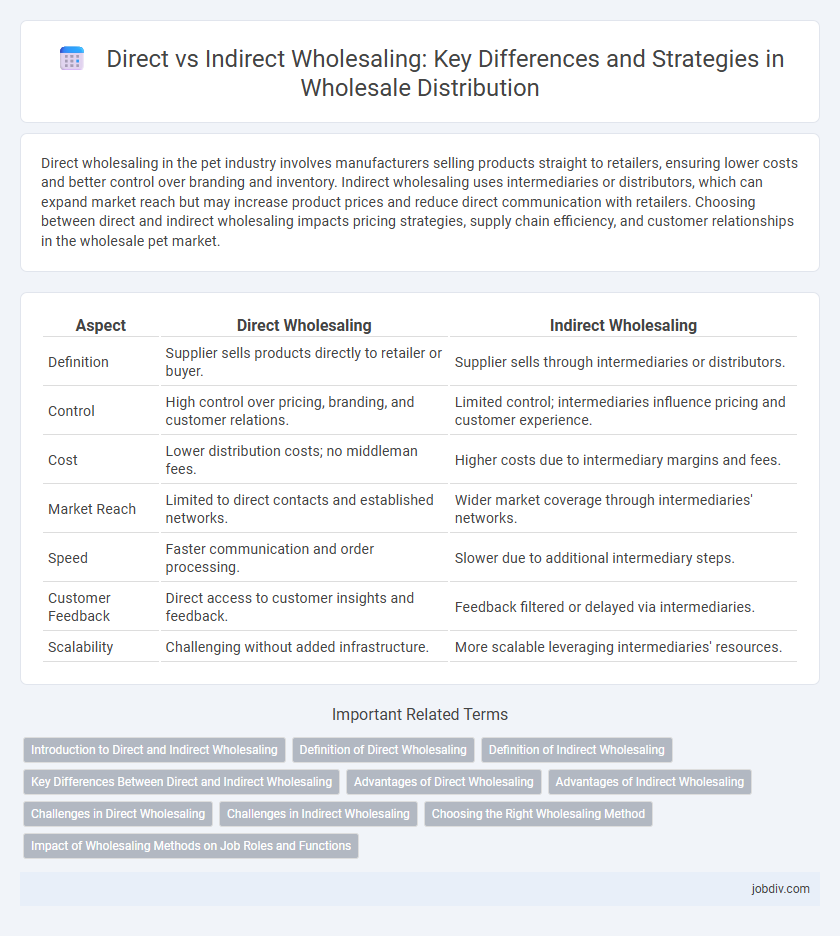Direct wholesaling in the pet industry involves manufacturers selling products straight to retailers, ensuring lower costs and better control over branding and inventory. Indirect wholesaling uses intermediaries or distributors, which can expand market reach but may increase product prices and reduce direct communication with retailers. Choosing between direct and indirect wholesaling impacts pricing strategies, supply chain efficiency, and customer relationships in the wholesale pet market.
Table of Comparison
| Aspect | Direct Wholesaling | Indirect Wholesaling |
|---|---|---|
| Definition | Supplier sells products directly to retailer or buyer. | Supplier sells through intermediaries or distributors. |
| Control | High control over pricing, branding, and customer relations. | Limited control; intermediaries influence pricing and customer experience. |
| Cost | Lower distribution costs; no middleman fees. | Higher costs due to intermediary margins and fees. |
| Market Reach | Limited to direct contacts and established networks. | Wider market coverage through intermediaries' networks. |
| Speed | Faster communication and order processing. | Slower due to additional intermediary steps. |
| Customer Feedback | Direct access to customer insights and feedback. | Feedback filtered or delayed via intermediaries. |
| Scalability | Challenging without added infrastructure. | More scalable leveraging intermediaries' resources. |
Introduction to Direct and Indirect Wholesaling
Direct wholesaling involves manufacturers selling products straight to retailers or consumers, eliminating intermediaries to reduce costs and increase control over distribution. Indirect wholesaling relies on intermediaries such as distributors or agents to bridge the gap between producers and retailers, facilitating market reach and logistics management. Understanding the differences between direct and indirect wholesaling is crucial for businesses aiming to optimize supply chain efficiency and market penetration.
Definition of Direct Wholesaling
Direct wholesaling involves manufacturers selling goods straight to retailers or businesses without intermediaries, streamlining the supply chain and reducing costs. This method enhances control over pricing, inventory, and customer relationships, ensuring faster order fulfillment and better market responsiveness. Industries such as electronics, apparel, and consumer goods benefit significantly from direct wholesaling strategies.
Definition of Indirect Wholesaling
Indirect wholesaling involves distributing products through intermediaries such as distributors, brokers, or agents who facilitate sales between manufacturers and retailers. This method reduces direct contact between producers and end sellers, often expanding market reach and leveraging established networks. Indirect wholesaling enables manufacturers to focus on production while intermediaries manage logistics, marketing, and customer relationships.
Key Differences Between Direct and Indirect Wholesaling
Direct wholesaling involves manufacturers selling products straight to retailers or consumers, eliminating intermediaries and enabling better control over pricing and inventory. Indirect wholesaling uses intermediaries such as distributors or agents to distribute goods, which increases reach but reduces profit margins and control. Key differences include the level of control, cost structures, and the complexity of supply chain management.
Advantages of Direct Wholesaling
Direct wholesaling offers advantages such as greater control over pricing, branding, and customer relationships, leading to improved profit margins. Businesses can respond faster to market changes and customize orders to meet specific client needs. This approach reduces reliance on intermediaries, decreasing costs and enhancing supply chain transparency.
Advantages of Indirect Wholesaling
Indirect wholesaling offers advantages such as reduced operational complexity and lower upfront costs by leveraging intermediaries like distributors and agents to handle logistics and marketing. This approach enables wholesalers to access broader markets and customer networks without investing heavily in infrastructure or sales teams. The reliance on established partners facilitates faster product distribution and risk mitigation in volatile market conditions.
Challenges in Direct Wholesaling
Direct wholesaling faces challenges such as higher operational costs due to managing logistics and inventory without intermediary support, requiring substantial investment in distribution infrastructure. Maintaining strong customer relationships demands consistent communication and personalized service, which can strain internal resources. Furthermore, direct wholesalers must navigate complex regulatory compliance and market fluctuations independently, increasing risk exposure.
Challenges in Indirect Wholesaling
Indirect wholesaling presents challenges such as reduced control over brand representation and pricing due to reliance on intermediaries. Communication breakdowns can occur between manufacturers and retailers, complicating inventory management and demand forecasting. Limited visibility into consumer behavior through indirect channels often results in slower response times to market changes and customer needs.
Choosing the Right Wholesaling Method
Choosing the right wholesaling method hinges on evaluating control, cost, and distribution reach. Direct wholesaling offers greater control over pricing and customer relationships but demands higher operational expenses and logistical management. Indirect wholesaling leverages intermediaries to expand market access and reduce overhead, though it may dilute brand influence and profit margins.
Impact of Wholesaling Methods on Job Roles and Functions
Direct wholesaling centralizes control over inventory management, customer relations, and sales strategy, requiring job roles to focus on logistics coordination, direct communication with buyers, and real-time market analysis. Indirect wholesaling disperses responsibilities across intermediaries, emphasizing roles in partnership management, contract negotiation, and distribution network optimization. Each method profoundly shapes the skillsets, decision-making authority, and workflow processes of wholesale professionals.
Direct Wholesaling vs Indirect Wholesaling Infographic

 jobdiv.com
jobdiv.com